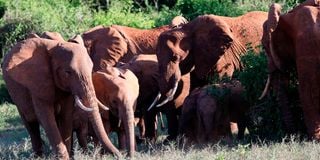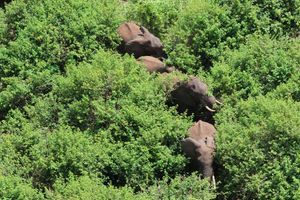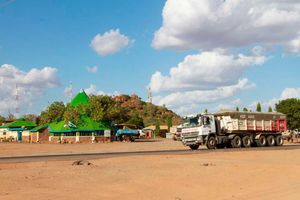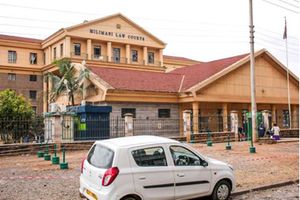Illegal grazing tearing down Tsavo West National Park, shows report

A herd of elephants feeding at the Taita Hills Wildlife Sanctuary within the Tsavo West National Park in Taita Taveta County.
What you need to know:
- The Tsavo Conservation Area is one of the largest wildlife reserves in the world, covering an area of over 21,000 square kilometres
A preliminary report from the recently concluded elephant census at the Tsavo Conservation Area has raised concerns over illegal grazing activities within Tsavo West National Park.
The report indicates that herds of cattle have been sneaked into the park, posing a significant threat to the delicate ecosystem and the wildlife that inhabit the area.
Apart from devastating pastures, livestock are also blamed for pushing wild animals out of the park and causing human-wildlife conflicts.
Speaking during the release of the report, principal research scientist at the Wildlife Research and Training Institute (WRTI) who led the census, Dr Joseph Mukeka, said illegal activities undermine ongoing efforts to protect the park's biodiversity.
"Our ecosystem is seriously threatened by human activities, including livestock incursion, charcoal burning and logging. Tsavo East is devoid of livestock except for a few areas, but there's a problem in Tsavo West," he said.
He noted that increasing human pressures are putting this rich biodiversity, which covers an area of 9,065 square kilometres, at risk.
"As much as we are collecting data for the elephant census, we cannot shy away from the real issues that are affecting conservation within our ecosystem," he said.
He said livestock invasions in the protected areas need to be addressed by enforcing strict measures against illegal grazing.
Dr Mukeka noted that the presence of large numbers of cattle is putting immense pressure on the park's resources, and that elephants are seemingly avoiding areas invaded by livestock.
The Tsavo Conservation Area is one of the largest wildlife reserves in the world, covering an area of over 21,000 square kilometres. It is also one of Africa's most incredible landscapes and Kenya's oldest and largest national parks.
The devastating drought of 2021, driven by climate change, left an indelible mark on the wildlife in the Tsavo ecosystem.
It particularly affected newborn and older animals, decimating populations of elephants, buffaloes, giraffes and antelopes.
Dr Mukeka, however, said the population of elephants has grown and most of the wildlife are found within the Tsavo National Park.
"We are not doing badly in terms of population growth even though the park experienced severe drought," he said.
Speaking at the closing ceremony of the exercise, WRTI director Patrick Omondi said the final results of the National Wildlife Census 2024-2025 will be released in June.
He said the census findings will directly support conservation planning, helping protect the country's diverse wildlife and maintain Kenya’s global reputation as a leader in wildlife conservation.
The institute’s board chairperson David Nkedianye said the findings from the census will provide a detailed overview of species distribution and habitat changes.
He added that the results will provide valuable insights into the dynamics of wildlife populations over the years.
“Once the results are released in June, we will give a better picture of species distribution and habitat changes over the years,” he said.
Mr Nkedianye noted that the data collected will be instrumental for local communities neighbouring wildlife, particularly county governments, in making informed decisions that align with the government's Bottom-Up Economic Transformation Agenda to enhance tourism.
He said the strategic approach aims to foster economic growth through sustainable practices.
"By understanding the shifts in species distribution and habitat conditions, stakeholders can better address environmental challenges," he said.
"The results of this census will play a crucial role in shaping conservation strategies and promoting sustainable tourism, further solidifying Kenya’s reputation as a leader in wildlife protection and ecological sustainability."
In addition to illegal grazing, the park has experienced a high occurrence of wildfires within its boundaries in the recent past.
The fires have destroyed large swaths of vegetation, reducing available forage for wildlife and altering the park's ecological balance.
In a recent interview, Tourism and Wildlife CS Rebecca Miano attributed the recent surge in wildfires in some parks to a combination of human activities and extreme weather conditions.
She said that some fires were started by honey harvesters, farmers clearing land for cultivation, and individuals engaging in arsonry.
In certain cases, she noted, cultural beliefs linking fire to rainfall also contributed to deliberate ignitions, while careless smoking and the improper disposal of cigarette butts further exacerbated the problem.
She said these activities, coupled with prolonged dry conditions and high temperatures, have created an environment highly susceptible to wildfires.
"The government is strengthening fire management strategies, including the enhancement of early warning systems, the creation of firebreaks, and the implementation of community education programs to raise awareness about fire prevention. Wildfires not only destroy vegetation but also displace wildlife, disrupt ecosystems, and threaten biodiversity," she said.
She assured that the KWS teams are actively engaged in the rehabilitation of affected animals, and plans are in place to restore damaged habitats.





